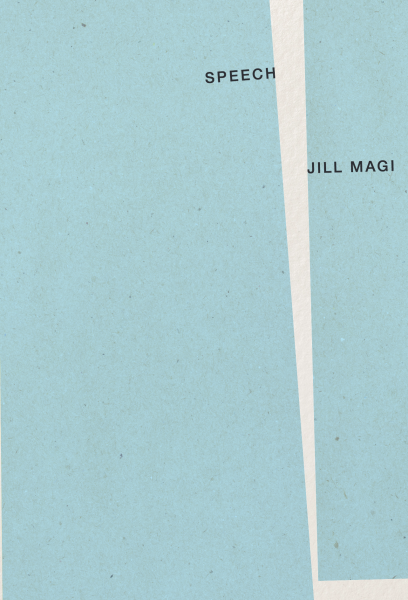
Abu Dhabi-based poet and artist Jill Magi furnishes SPEECH, her new book-length poem published earlier this month, with layered textures of language, subject, and object, calling at the delineations of border and sending her subject through them. That subject, however, “won’t be indexed precisely,” Magi asserts in the books appendix, “Painting a bibliography.” She asserts further that SPEECH is as much an archive, of painting– of movement– of place, as it is a poetic engagement. In the interest of highlighting that pervasive materiality of this new text, Jill Magi has given us a photographic opening into the creative spaces that fostered SPEECH and its methodology: the city, the studio, the objects, the energies. Peer in and be warmed!
-June Shanahan
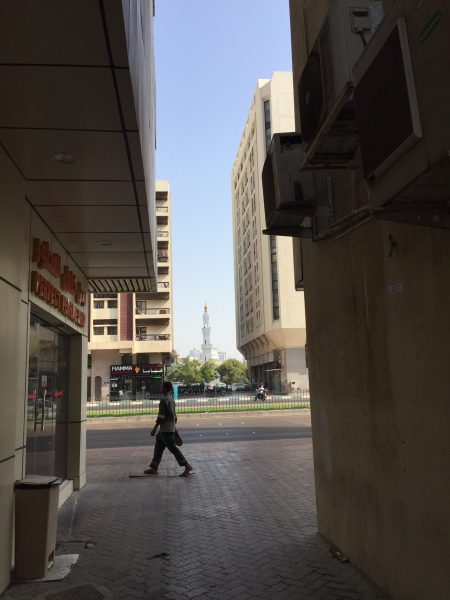
Here are pictures of my neighborhood and objects that I found on the sidewalks—objects I’ve been taking back to my studio to paint. I took this walk on Sunday and it was nearly 100 degrees. Still, there is street life. There are electrical supply shops, clothing stores, grocery stores, furniture stores, curtain and upholstery shops, mosques, offices, banks open and functioning. People are making their way to shifts at the hospitals. Some parents are picking their kids up from school. Even though it’s hot, I like to go out for walks—to run small errands down the block. SPEECH is about this—going out and into the city.
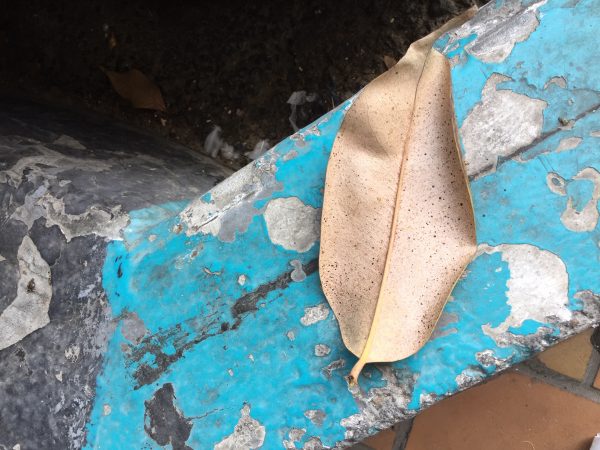
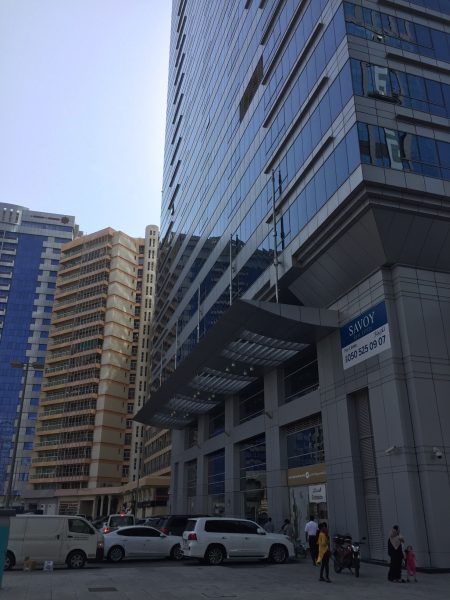
On this particular day I needed to drop off something for photocopying. And then on my way home I stopped by a very small electrical and lighting shop—I live in a building on “Electra Street,” the historical home of such shops—where I asked the two gentlemen who run the shop if they could wire up four lightbulbs for me on one long black cord. It’s for an installation where I’ll place the lightbulbs behind some paintings where I want the stretcher bars and the mechanics of the painting to shine through. I made a quick sketch for them. They said “yes, no problem” and I sat down and waited as they wired it up for me on the spot. In Abu Dhabi it is very easy to get custom things made for you without placing a special order. This is excellent for artists.
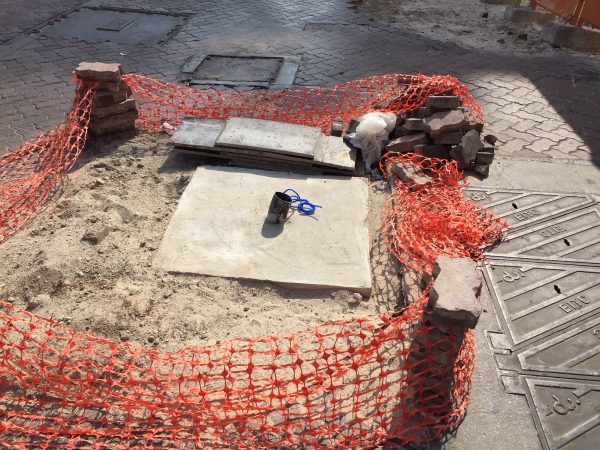
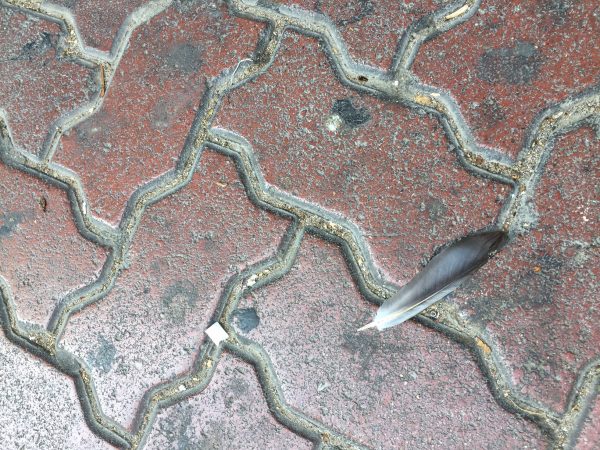
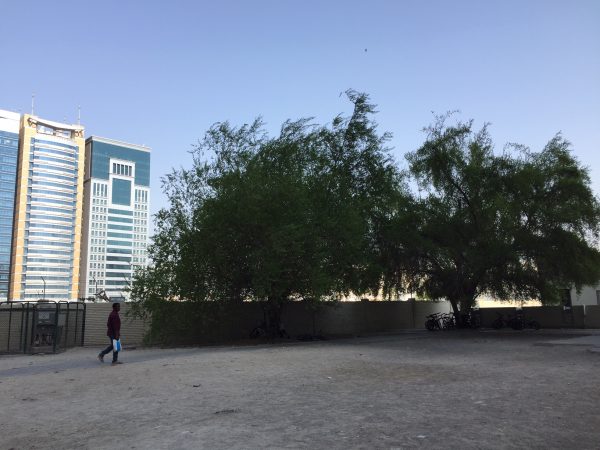
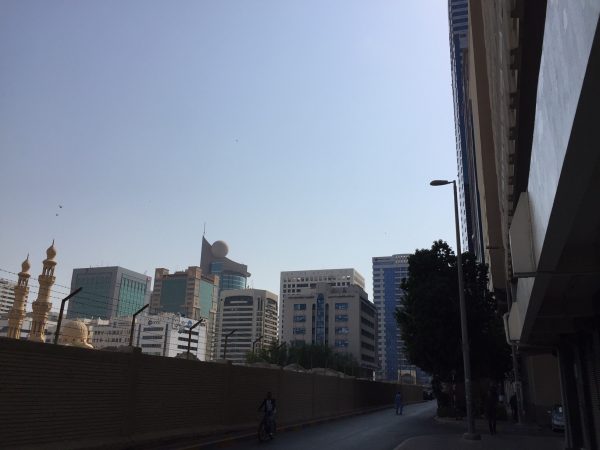
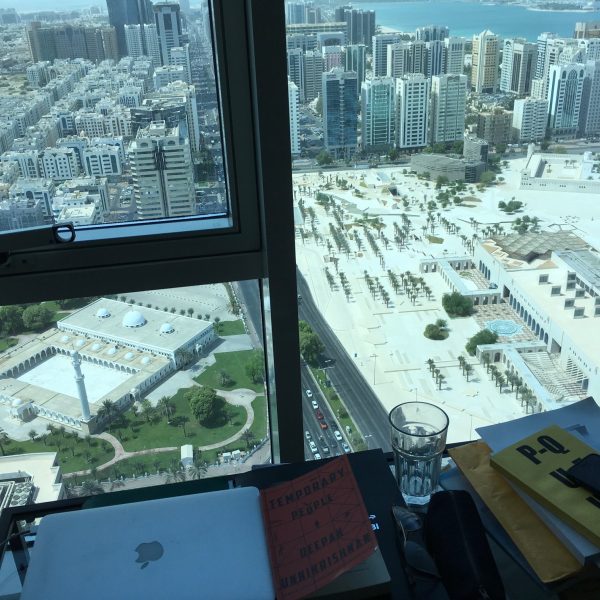
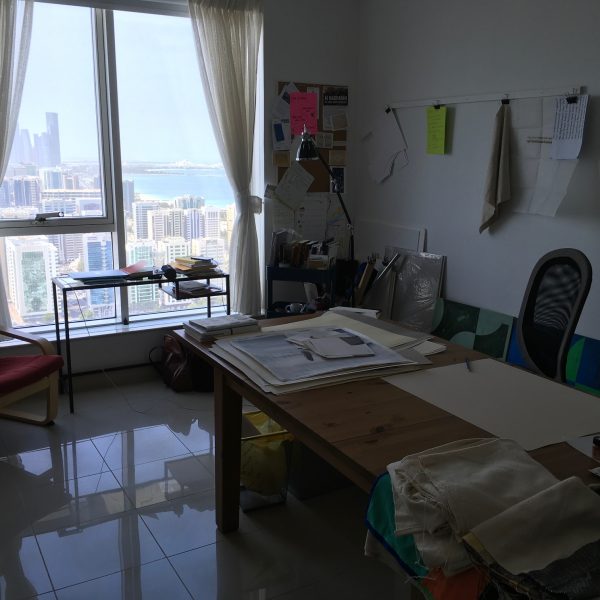
Here are some pictures of my studio and the stack of object paintings I’ve been making. Another thing that’s easy to buy in Abu Dhabi are stamps for documents. I think the availability of stamps here is a holdover from the days when the UAE was a British protectorate. I googled “document stamps” and found a second-story shop that specializes in all kinds of stamps: ready-mades to custom stamps. My archive of object paintings are all stamped with a number. I figured any archive that has repeated images should have some kind of numbering system.
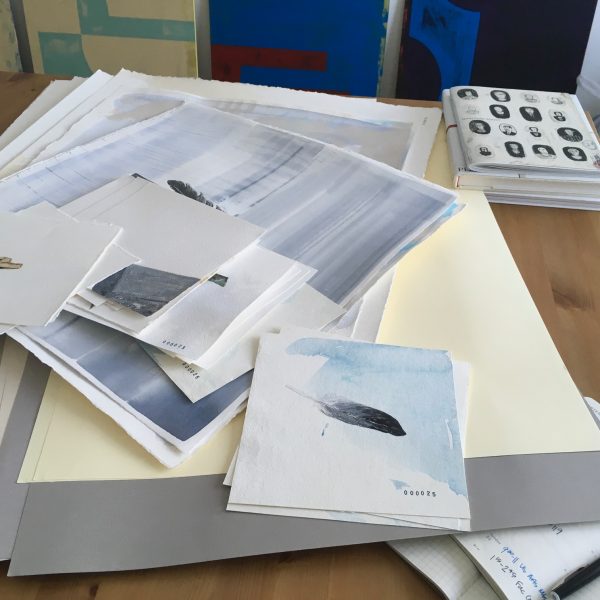
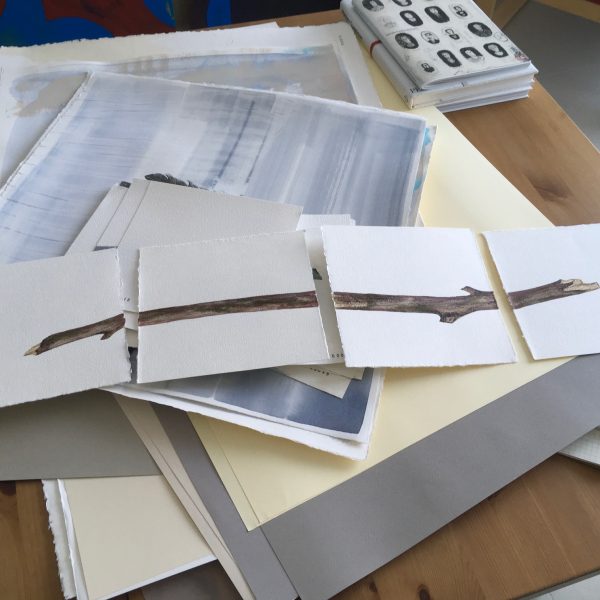
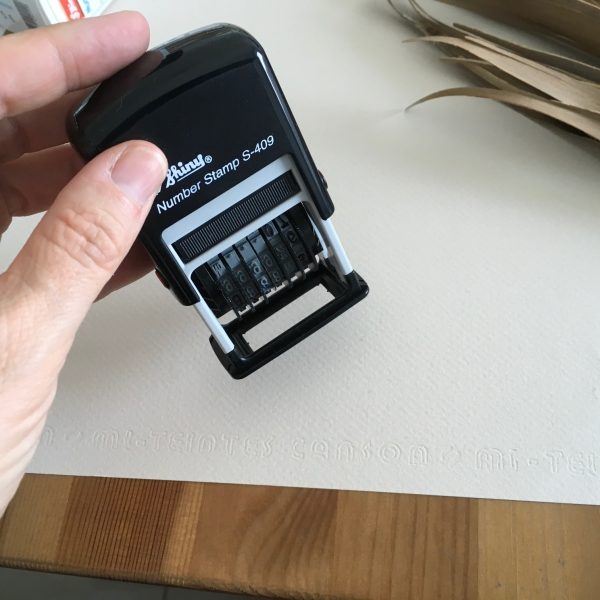
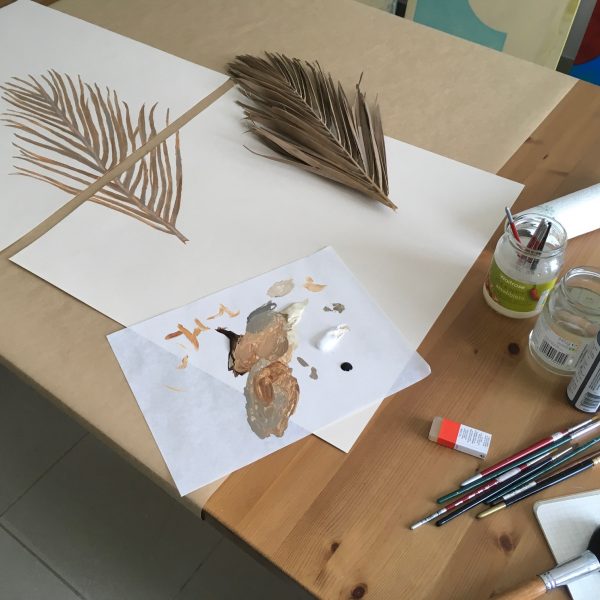
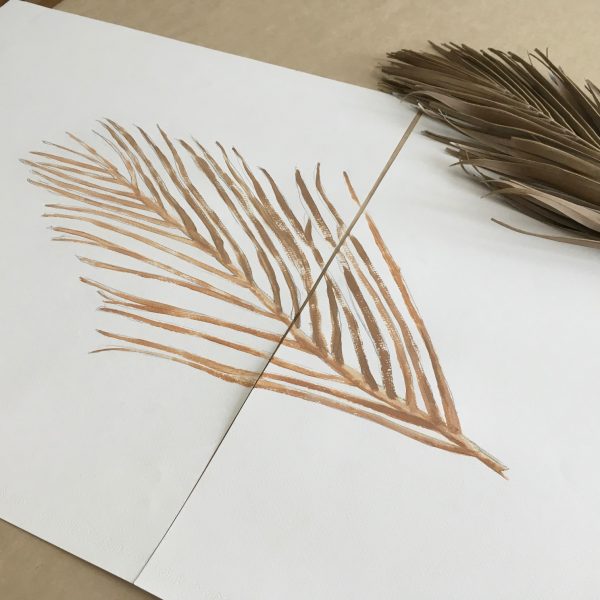
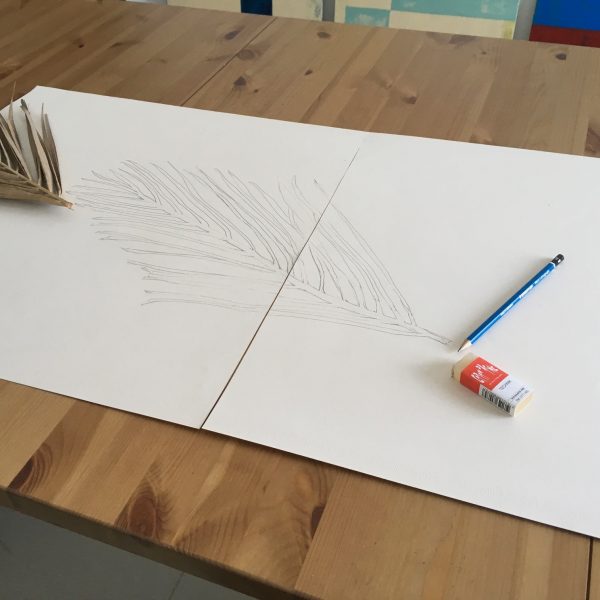
Here are photos of a painting I made today. The palm frond is the quintessential Abu Dhabi item from the natural world. Date palms are abundant here—there are delicious drinks and cookies and candies featuring dates. It’s customary to bring some dates to someone’s house if you are visiting them. During Ramadan people break their fast with dates and tea, and I’ve taken to having coffee, dates, and water when I wake up in the morning. Back the palm frond: it’s a common thing here, but it is the most time-consuming and difficult object for me to paint. It’s tricky because it is so structured and organized, and yet the leaves that extend off the spine are abundant and kind of wild and bushy. Also its color appears, at first, to be really uniform, so it takes me a while to really see the subtle differences. I think that may all be a really apt metaphor for the Emirates.
As I paint any object, and especially this palm frond, I begin with the idea of precision and I feel committed to the task of rendering a likeness. I make a pencil sketch first. At this stage I am really trying to get proportions and dimensions right. But as I paint, I begin to learn the energy of the object, and so I depart from precision. Specifically, the palm frond is so much about reaching out—the outward-reaching energy of each leaf from that spine. So I end up abandoning precision and go for movement instead—I try to load up my brush with paint and in one or two strokes, move out quickly from the spine to make a sure and graceful shape. Inevitably, because the brush runs out of paint and the paper has a tooth to it, solid lines give way to “brushy” lines—not fully complete, but indicating, to the viewer, that motion is involved. At this point I have a choice: does the painting represent the energy of the object and its outward motion, or do I go back and turn those brushy lines into solid lines? In the case of this painting, I’ve chosen something in between. I want to communicate care and time in this painting, but I also want to give the feeling of motion and reach.
It is incredible to learn about an object by painting it. I also constantly learn about myself—how tenuous sight is, how much feeling and motion are a part of knowing. The object and I feel alive together. I believe, intellectually, that all matter is alive. The act of painting an object is a way to really live this liveliness.
Corollaries in SPEECH are these: with each step, walking, I am knowing and forgetting myself, knowing and forgetting this place, making and unmaking space, with others and with objects of the built environment. Going back to my studio, I write. Stroke by stroke, language moves out and away from me, from my spine, from the spines of others’ books. And because it is poetry, words move away from stable meanings and originary contexts into combinations that are lively. Things happen beyond what I could have imagined and planned. Everything—the city, myself, my neighbors, the pavers, the feathers, the poetry, twigs, leaves, the paintings—are charged with energy but this energy doesn’t make them remarkable or unique. Rather, we are all knots in a network and art is to help us know this, sense this. Archive of sensation. +
Order your copy of SPEECH here!
Jill Magi works in text, image, and textile and her books include Threads, Torchwood, SLOT, Cadastral Map, LABOR, SIGN CLIMACTERIC, and a monograph on text-image entitled Pageviews/Innervisions (Rattapallax/Moving Furniture Press). Recent work has appeared in Best American Experimental Writing 2018, Boston Review, Tupelo Quarterly, Pheobe, and Rivulet. In October of 2017 Jill blogged for the Poetry Foundation, and in the spring of 2015 Jill wrote weekly commentaries for Jacket2 on “a textile poetics.” Her essays have appeared in The Edinburgh University Press Critical Medical Humanities Reader, The Force of What’s Possible: Accessibility and the Avant-garde, The Racial Imaginary: Writers on Race in the Life of the Mind, and The Eco-Language Reader. Jill has been awarded residencies with the Lower Manhattan Cultural Council Workspace program, the Brooklyn Textile Arts Center, and has had solo shows with Tashkeel in Dubai and the Project Space Gallery at New York University Abu Dhabi. For her community-based publishing work, Poets & Writers magazine named her as among the most inspiring writers in the world in 2010. Jill teaches in the literature/creative writing and visual arts programs at NYU Abu Dhabi where she joined the faculty in 2013.
